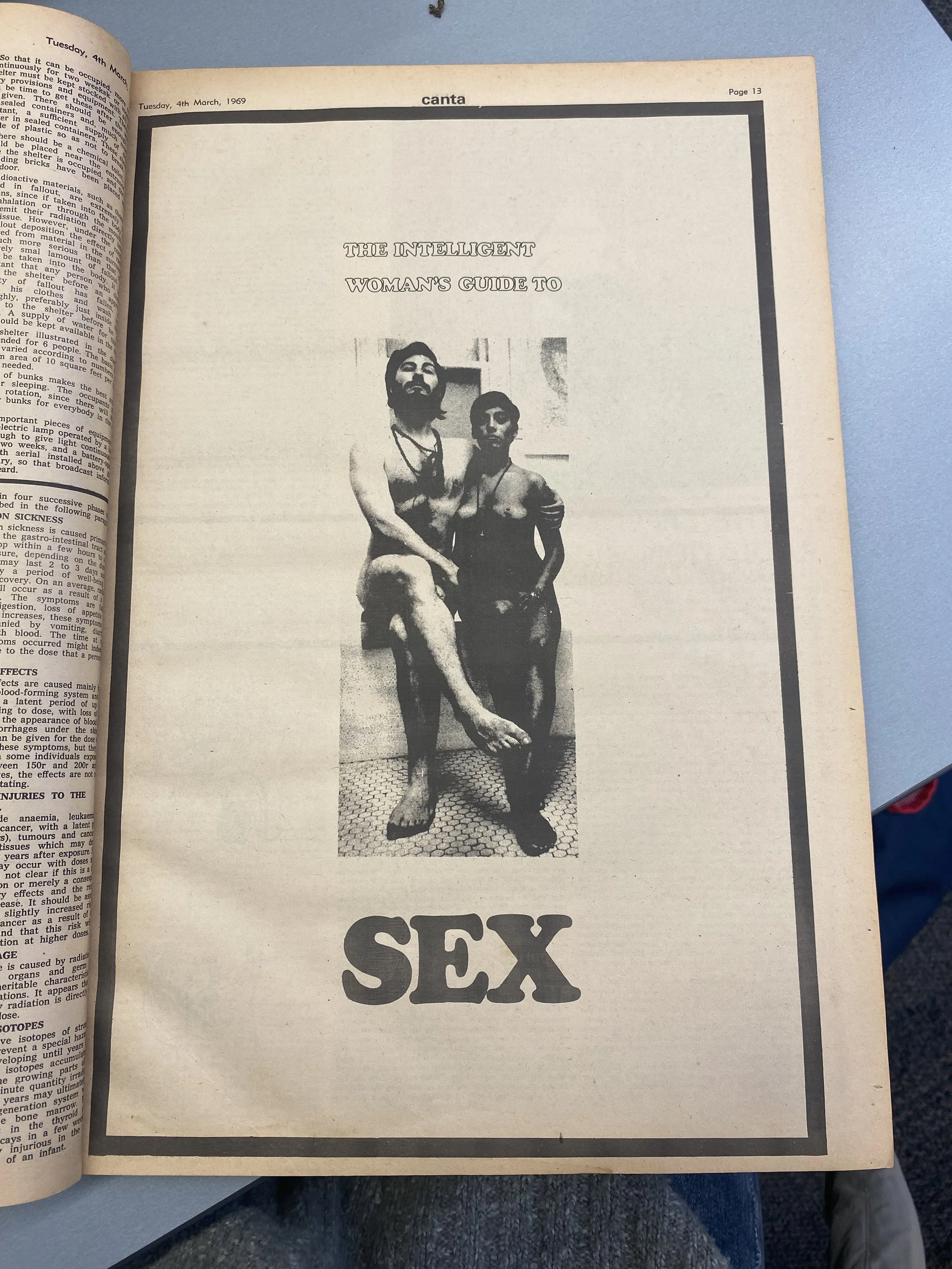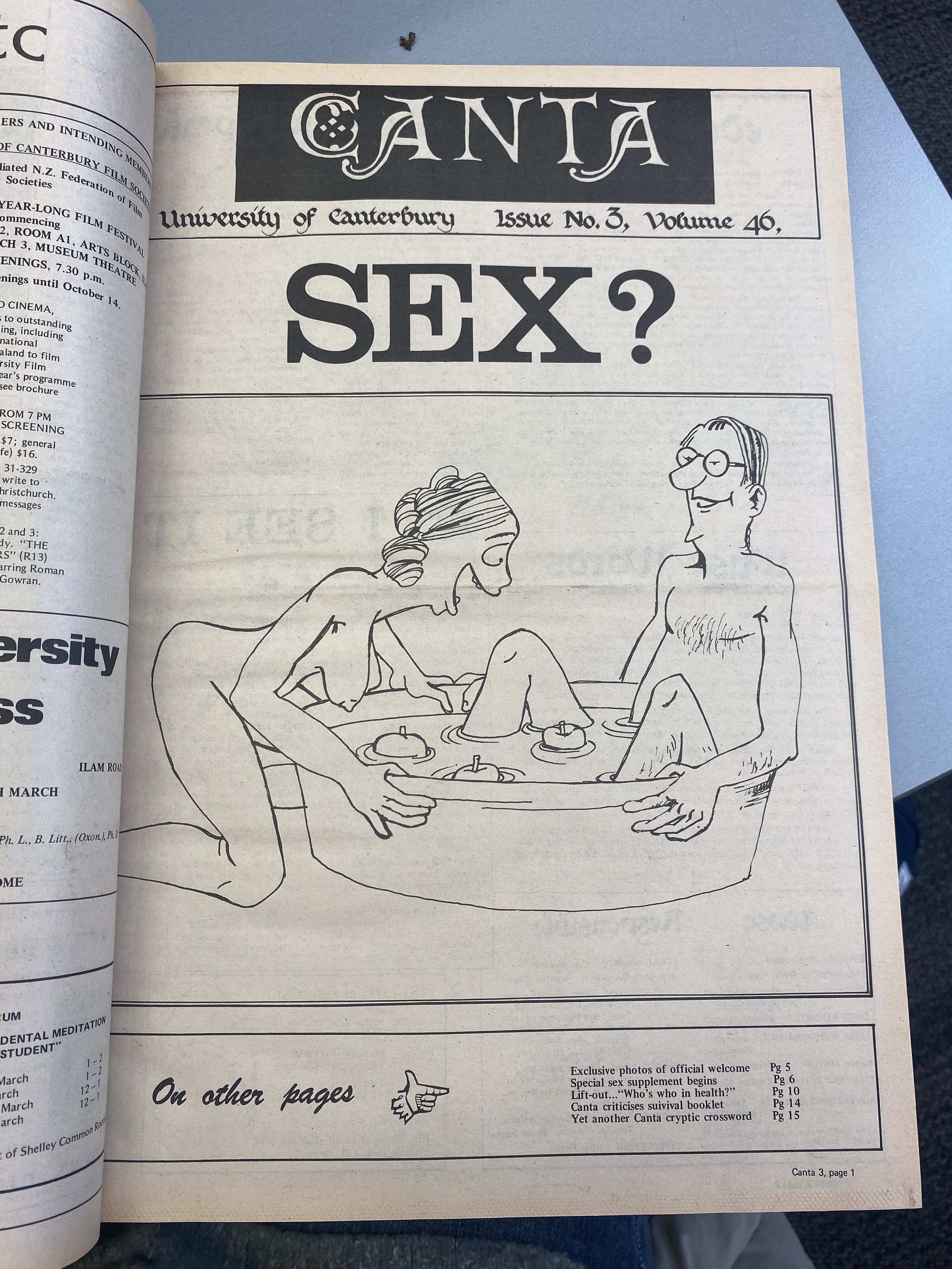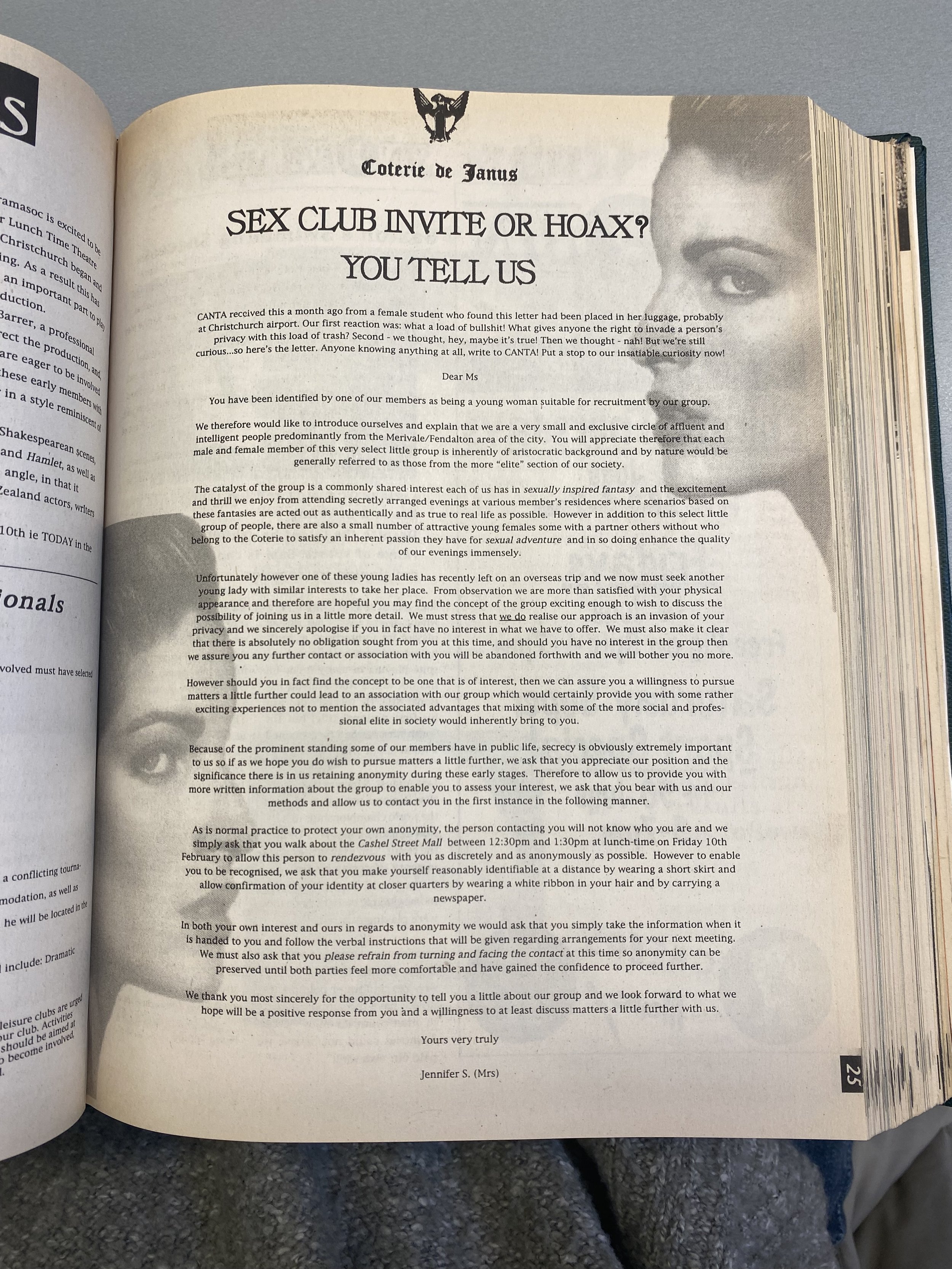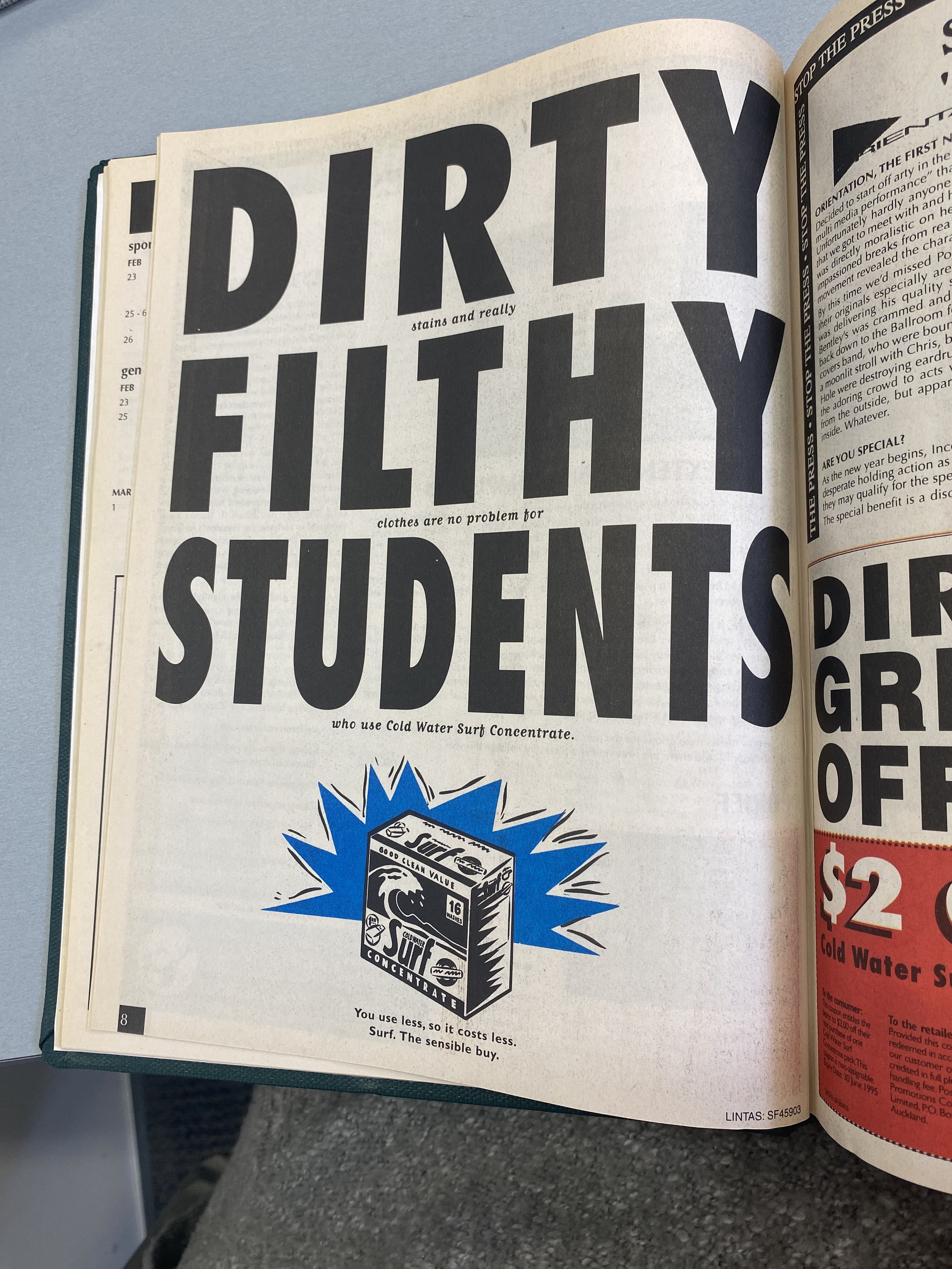Canta & Sex
Canta 1969, An Intelligent Woman’s Guide To Sex
Student media sure does some crazy things.
From nude covers and satirical commentary to calling out university failures and breaking fresh stories, there’s no denying the structured chaos of it all. As the so-called runt of New Zealand media, student magazines fly under the radar and remain to be one of the lasting remnants of print media. Canta, of course, is no different.
In this modern era of ultra PC-ness, student mags exist in a completely different environment than they did even 50 years ago. The world is both gaining political consciousness and are openly discussing once unspeakable things but operates in a space where there is no room for mistakes. There’s been plenty of backlash surrounding the highly contentious issues we cover but most of student media’s most controversial moments almost always come from one iconic topic, sex.
Thankfully for research’s sake, our very own Macmillan Brown Library carries virtually every issue of Canta from 1969 (ironic).
If you read nothing else, go read the 1969 issues because they’re weirdly similar to a 2023 Canta. You’d think after all this time, the student body would have changed but we’re still little shits whining about student loans and social issues.
The 1969 editions of Canta are shockingly graphic and low-key raunchy considering that it was the 60s, though this was printed during the liberating Sexual Revolution of the Western World that happened from the 1960s to the 1970s. Their sex edition features an article titled, “An Intelligent Woman’s Guide To Sex,” on the basis that “no girl at university can afford to become pregnant.” More interestingly, the cover is a photograph of a completely nude man and woman, looking stoically at the camera as they artfully cover their lower halves.
It shows its time and place as you read the article though, the writer stating that “If she does become pregnant, she’ll either have to have an abortion, which is costly and always traumatic, or she’ll go through with it all and suffer the greater trauma of being an unmarried mother.”
The issue also had an article called, “Phallic Worship: The Origin of Sex and Religion and the Significance of Sex,” which has detailed descriptions of unsuspectingly phallic objects along with some very outdated contraceptive methods and even more naked bodies. Not surprisingly, it was met with backlash. The letters to the Editor section shows several letters from people who are outraged at the “misleading and dangerous” depictions of sex. One even suggests that the only contraceptive method necessary is “abstinence before marriage.”
As the years progressed, our Canta ancestors never shied away from a contentious cover. The 1976 Issue 7 depicts Uncle Sam clutching an outline of New Zealand with pube-like squiggles covering the Tasman and Wellington regions, headlined “AMERICA: Got us by the short and curlies!”
Canta 1976 Issue 7 Cover
Or better yet, their sex issue featured a fun little cartoon of some very adventurous ‘apple bobbing.’
The editions of Canta from the 80s shift away from the outright graphicness of sex and are more geared towards the social issues that surround it like rainbow rights, women’s rights and law reforms. The homosexual law reform that passed in 1986, which meant homosexual relations between men was decriminalised, was a contentious topic and in true student media fashion, it graced almost every page.
Considering the political and social climate of the 80s, it’s no surprise that student mags didn’t talk as much about just sex and instead gave people in the midst of controversy a voice. The 80s editions of Canta are tender and somewhat endearing. There’s letters of lesbians coming out to their parents for Lesbian Visibility Week and covers with collages of gay rights activists clutching signs that read “Hooray I’m Gay!” and “My grandmother loves me.” There’s op-eds about raising the age of consent to 12 to 16, and several informative pieces from women’s rights officer Phoebe Gray.
Canta 1976 Issue 3 Cover
Because even though sex and student media are basically synonymous, it’s not always about breaking down the explicitness of the act itself, but just as much about the nuanced topics and conversations that come with that. And that’s where student media often gets it right. Sure, there’s always gonna be a few dick pics and crude cartoons in there, but the coverage of such a typically taboo topic is so necessary. Being open, being able to make jokes and commentary is freedom.
But freedom within student media has always been a multifaceted idea.
With all student publications, they’re linked to a university and subsequent Student Association. Only a few years ago in 2019, Canta editor Samantha Mythen launched a petition against the UCSA’s pre-publication vetting of the magazine, claiming it was being censored. Articles were being pulled from the magazine and in 2015, an entire issue was recalled after it’s ‘poor taste’ about virtual rape. The petition received over 700 signatures and the following year, Canta gained editorial independence from the UCSA, following the format of University of Otago’s Critic and Victoria University’s Salient.
Current editor and print editor for Canta, Maddy Croad and Hariklia Nicola have explained Canta’s relationship with the UCSA saying it is “strictly professional and independent. We are in no way shape or form run by the UCSA. Canta’s managing editor is the person in charge of all final Canta decisions. Because of this, Canta can operate freely, be less PC and put in the magazine whatever is appropriate for our readers.”
Creative independence is imperative in how student media operates. As soon as an institution starts to censor content is when mags are restricted to a tertiary ideal instead of freely expressing opinions and advocating for students.
Things like alcohol, drugs, and sex, “are topics which are in almost every single students’ lives yet for some reason people just don’t want to talk about it!” according to Maddy and Hariklia. “We approach these topics like your mate, not your mum.”
Canta started getting into the real nitty gritty in their 90s issues, covering anything from homosexual relationships and transsexuality, sex toys, pornography and secret suburban sex clubs. Yes, secret sex clubs. In their 1995 sex issue, Canta released a letter that a female student had received, inviting her to join a prestigious sex club made up of ‘elites’ from the Merivale/Fendalton area. Unsure of whether this letter was an honest invite or an intricate hoax, Canta asked their readers for any information they had.
Canta 1995 Sex Issue, Sex club invite or hoax? You tell us
And then the story made national news.
The very next week, Canta released an article outlining the widespread attention the letter had received as they were “bombarded with calls from people who had seen or received letters, print media enquiries and of course television. TVNZ and TV3 both wanted to meet a lucky recipient of one of these letters.”
Turns out, the Police went with one of the young women who had received a letter to the rendezvous point where they found a lone 41 year old man. He had been distributing the letters for a few months and was “suitably embarrassed” about the trouble he had caused. No further action was taken.
But even beyond their sex issue, the advertisements from the 90s were also a little on the nose with some intentionally small font sizes calling out all of us “DIRTY FILTHY STUDENTS.”
Canta 1995, Surf advertising
Moving into the turn of the century, 2000s editions of Canta are exactly what you’d expect from students in that golden era. Notably the appearance of not just colour printing but advertisements set it apart from its predecessors. There were ads for events at The Foundry including a Bucking Bull Competition, a signing of calendars from Calendar Girls and an extremely enticing competition to win an iPod. Back when a pack of Cruisers was just $6.99 and Christchurch nurses were advertising jobs with “excellent rates of pay,” it’s clear that it really was a completely different time.
Issues from 2005 feature a column entitled “Sex and The Single Girls” where Genevieve and Nikki illuminate the trivial affairs of single women. It takes a more comedic approach, particularly in their “Performance Anxiety” edition of the column where both girls pretend to fall asleep when the other guy can’t get it up. Right beside it is a detailed investigation into thrush. Nice. But what’s clear from these articles is the deconstruction and normalisation of sex and in particular, bad sex, which in part can be put down to the beginnings of internet culture.
In 2005, the internet was just taking off and the spread of information was becoming increasingly rapid. As internet culture grew, people were able to access more information which helped to destigmatize sex. Before this point, information could be sourced from newspapers, magazines, or word of mouth, which was always subjective and at some point, censored. The internet allowed people to share in the not so great part of sex and be open about it.
As we hit the 2010s, we finally reach the era when uni mags are digitised!
Canta mags in the 2010s aren’t too different from the previous decade. They’re longer issues, keeping on trend with the rest of the media world. Notably, the appearance of crowd-favourite ‘Lucky Dip,’ puzzle pages and a fortnightly issue rather than a weekly issue meant a different landscape for Canta in the early 2010s.
From the late 2010s and into where we are now, as print is dying its slow yet predicted death, Canta shifts gears and adds other formats apart from the long-standing magazine format. Of course, we still have a magazine in both print and digital, but now there’s radio shows, Canta Banta, and we've even moved into the video space with Canta Can Canta Does. From employing type setters and print formatters back in 1969, we now have digital editors and contributors, and that is pretty freaking cool.
On the whole, Canta has always stayed true to itself but adapted to the new era of journalism and student mags.
Student media is alt-nerdiness and niche references, satire and inside jokes, but it takes risks and pushes boundaries. We break stories and cover old ones, provoke deeper thought, and probably encourage the loss of a few brain cells, but we will always entertain and educate our students. We are advocates and story-tellers, who speak on topics in a way that other news outlets would never dare. Canta has never steered away from taboo subjects and it will continue to do so as long as there’s any student who wants to listen.





